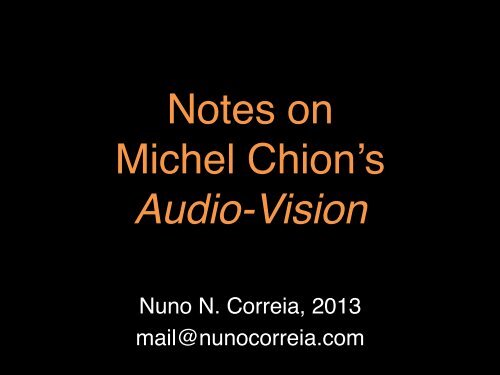“Audio-Vision” (pdf) - Nuno Correia
“Audio-Vision” (pdf) - Nuno Correia
“Audio-Vision” (pdf) - Nuno Correia
You also want an ePaper? Increase the reach of your titles
YUMPU automatically turns print PDFs into web optimized ePapers that Google loves.
Notes on Michel Chion’s Audio-Vision!<strong>Nuno</strong> N. <strong>Correia</strong>, 2013"mail@nunocorreia.com"
Chion on Persona"• “The house lights go down and the movie begins.Brutal and enigmatic images appear on the screen:a film projector running, a closeup of the film goingthrough it, terrifying glimpses of animal sacrifices, anail being driven through a hand. ""• Then, in more "normal" time, a mortuary. Here wesee a young boy we take at first to be a corpse likethe others, but who turns out to be alive—he moves,he reads a book, he reaches toward the screensurface, and under his hand there seems to form theface of a beautiful woman.” (Chion 1994, pp. 3-4) "
Chion on Persona"• “Stop! Let us rewind Bergman's film to the beginningand simply cut out the sound, try to forget whatwe've seen before, and watch the film afresh. Nowwe see something quite different. ""• First, the shot of the nail impaling the hand: playedsilent, it turns out to have consisted of threeseparate shots where we had seen one, becausethey had been linked by sound. What's more, thenailed hand in silence is abstract, whereas withsound, it is terrifying, real.”"
Chion on Persona!• “As for the shots in the mortuary, without the soundof dripping water that connected them together wediscover in them a series of stills, parts of isolatedhuman bodies, out of space and time. And the boy'sright hand, without the vibrating tone thataccompanies and structures its exploring gestures,no longer "forms" the face, but just wandersaimlessly. "• The entire sequence has lost its rhythm and unity.Could Bergman be an overrated director? Did thesound merely conceal the images' emptiness?”"
Audiovisual Contract"• Sound does not correspond "naturally" to an image."!• Audiovisual contract:"– "a kind of symbolic contract that the audio-viewerenters into, agreeing to think of sound and imageas forming a single entity" (Chion 1994, p.216).""
• Added value: "Added Value"– "the expressive and informative value with whicha sound enriches a given image "– so as to create the definitive impression, in theimmediate or remembered experience one hasof it, "– that this information or expression 'naturally'comes from what is seen, "– and is already contained in the imageitself" (Chion 1994, p.5)."
Added Value"• Added value works reciprocally: "– on the one hand, "sound shows us the image differentlythan what the image shows alone"; "– on the other hand, image "makes us hear sounddifferently than if the sound were ringing out in thedark" (Chion 1994, p.21)."• Added value is the most important of the relationsbetween sound and image (Chion 1994, p.5). "
Synchresis"• Based on the idea of synchronization (and alsosynthesis), Chion created the notion of synchresis:"– "the forging of an immediate and necessaryrelationship between something one sees andsomething one hears at the same time" (Chion1994, p.224)."
Synchresis"• According to Chion, synchresis allows for numerouscombinations of possible sounds with possibleimages: "for a shot of a hammer, any one of ahundred sounds will do" (Chion 1994, p.63)."• But random associations may not generatesynchresis: "play a stream of random audio andvisual events, and you will find that certain ones willcome together through synchresis and othercombinations will not" (Chion 1994, p.63)"
Senses as Channels"• Chion states that there is no "sensory given" that isisolated from the start: "the senses are channels,highways more than territories or domains”."• He clarifies this, stating that "when Kineticsensations organized into art are transmittedthrough a single sensory channel", they can conveyall the other senses via that one channel. (Chion1994, p.137). "• He exemplifies with the inherent visuality of concretemusic, and the implied sound behind silent movies. "
Bibliography"• Chion, M., 1994. Audio-Vision: Sound on Screen,New York: Columbia University Press."!""""Notes by <strong>Nuno</strong> N. <strong>Correia</strong>, 2013"www.nunocorreia.com"


